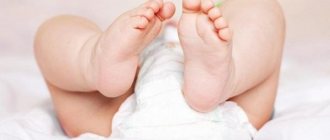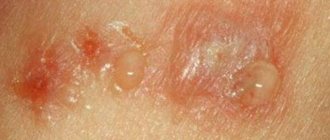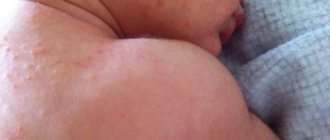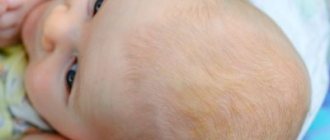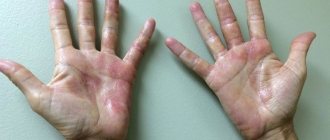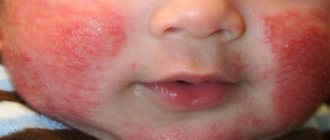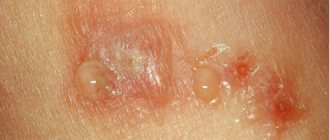From this article you will learn:
- What is fungal diaper dermatitis?
- candidiasis diaper dermatitis - photo;
- why candidal dermatitis in children is rarely diagnosed;
- causes of diaper dermatitis;
- diaper dermatitis - treatment (ointments and creams);
- features of candidiasis diaper dermatitis;
- fungal diaper dermatitis - treatment;
- prevention of diaper dermatitis;
- Does the quality of the diaper matter?
Candidal dermatitis is a disease that affects the skin, skin appendages, and internal organs. The symptoms of candidiasis dermatitis are caused by fungi that belong to the genus candida and are opportunistic.
I encountered the problem of candidiasis diaper dermatitis (photo) as a doctor and an experienced mother of two children! Since with my first child there were no problems under the diaper for a year and a half, I sincerely began to assume that mothers whose children regularly develop diaper rash were themselves to blame. In part, I turned out to be right. We’ll find out why partly now.
So my second child suddenly developed diaper rash. But every day the number of elements of the rash increased, they merged and turned into a large bright red spot, hot to the touch, with small, barely noticeable peeling on the border with healthy skin. And then I found out how many different creams, ointments, and powders there are on the pharmaceutical market.
I followed all the prescribed recommendations:
- air baths - the child was without a diaper more than with it;
- daily bathing in herbal decoctions (chamomile);
- washing after each urination and defecation;
- frequent diaper changes;
- using various ointments, creams, even learned what powder is.
There was no effect from Bepanten cream, from Sudocrem, from Drapolene. After each bath, it seemed to me that the rash was getting smaller, but it seems that I wanted to believe it. The rash has migrated.
I opened each new remedy with the hope that our healing was in this tube. But my despair only grew.
All sources and textbooks say that diaper dermatitis goes away on its own in a few days. I realized that my few days were already more than two weeks and I kept expecting them to end soon. All pediatricians I knew recommended air baths, bathing and tried ointments. While in practice, I saw the same poor children in the hospital, without diapers, smeared with fucorcin and without much improvement in their condition.
And when I found information about candidiasis diaper dermatitis and gave the child antifungal drugs (fluconazole and clotrimazole ointment), the rash successfully disappeared.
It turns out that most pediatricians also do not suspect candidiasis diaper dermatitis? Why?
Because during my 8 years of studying at a medical university, not a single teacher mentioned this. Because there is an opinion that skin candidiasis can only occur in immunodeficiency states (most often HIV) - but this is not so.
What does skin dermatitis look like?
Usually the disease occurs where the diaper or diaper comes into contact with the skin.
If the rash is noticeable on the cheeks and ears, then the disease is progressing and pathologies have already arisen. In this case, the doctor must conduct a narrow diagnosis. General symptoms of candidal dermatitis are expressed as follows:
- severe inflammation of the skin is observed in the area of the buttocks, anus, and genitals;
- the affected areas of the skin may be dry or moist (in severe cases);
- the upper epidermis is covered with small pimples, sometimes wounds and ulcers appear;
- inflamed skin – bright red, may peel;
- when touching the affected areas, the patient feels pain, small children begin to be capricious and cry;
- If diaper rash occurs in the perineal area, the child cries during and after urination.
If there is no treatment, blisters and abrasions form on the skin. A coating of cheesy consistency may also appear.
Features of the disease in newborns
According to statistics, candidal diaper dermatitis develops in babies in the second half of the first year of life (6 – 8 months). But sometimes they get it immediately after birth. A child can become infected even in the womb if a woman has candidiasis. The disease is also transmitted through household items and pets.
In medicine, there are three degrees of diaper dermatitis. At the initial stage, small inflammations on the skin, similar to abrasions, are visible. With proper and timely care, they quickly disappear.
The second stage is marginal dermatitis. It occurs due to friction of the baby's skin against the edges of the diaper. A rash is visible on the skin, it itches constantly. The baby becomes capricious and cries often. In the third degree, the perianal area is affected. Inflammation is observed in the area of the anus, genitals and.
This causes additional discomfort during bowel movements.
Symptoms of pathology
Candidiasis diaper dermatitis occurs in places where the baby's skin comes into contact with traces of feces and urine on things.
- Candidiasis diaper dermatitis
The rash hurts the baby. He becomes nervous and anxious and tries to remove the diaper on his own. His hands touch the groin area all the time.
- The rash lasts for more than four days.
- The first manifestations of candidiasis diaper dermatitis are observed in the area of wearing diapers in the form of redness, which may be accompanied by blisters and peeling of the skin. With a complex course of the disease, ulcers appear, swelling and suppuration of the affected areas of the skin are observed.
- Appears on the genitals, in the area of the butt and folds on the legs. The appearance of small pink papules indicates candidiasis diaper dermatitis.
- Candidiasis diaper dermatitis can occur when complementary foods are introduced into children's diets. If the child is bottle-fed, the redness of the anus is influenced by baby feces. Breastfed children do not often suffer from this disease.
- The color of the rash is bright red, which manifests itself in the form of pain and causes anxiety in the baby.
To establish an accurate diagnosis, it is necessary to undergo clinical and laboratory tests. If the folds of the skin are reddened, it is necessary to diagnose the child for the presence of candidiasis, differential and primary diaper irritative dermatitis.
Symptoms
Candidal dermatitis is quite recognizable by its symptoms:
- The affected areas of the skin change color - the skin acquires shades of pink, from light to bright crimson. This typically occurs in the buttock area and in folds such as the back of the elbow, knee or armpit.
- The affected areas can be either dry or wet (in advanced cases).
- Small pimples or small wounds appear on the affected areas.
- Intense burning and itching appears, intensifying when scratching.
In children, the accompanying symptoms of diaper dermatitis depend directly on the stage:
- Initial.
Small inflammations are noticeable on the body, which resemble abrasions. If you provide proper care in a timely manner, you can quickly get rid of them. - Regional dermatitis.
Formed due to friction of the baby's skin against the edges of the diaper. An itchy rash forms, which the baby tends to scratch. In general, the child becomes capricious and cries more often. - Perianal dermatitis.
Transition of the inflammatory process to the area of the anus, genitals, and inguinal folds. Children often scream and cry while going to the toilet.
The manifestation of even one symptom is a good reason to visit a dermatologist. And a pediatrician if symptoms are detected in a child.
How is the disease treated in children?
After the doctor has made a diagnosis, confirming that it is skin candidiasis, treatment begins. At the initial stage, the disease can be easily cured, even at home. Initially, baby drying powders are applied to the skin. After which the rash is treated with a solution of brilliant green (ordinary brilliant green).
The doctor will help you choose the right ointment based on the child’s age and general condition. The most popular antifungal drugs are "", "Pimafucin", "". “”, “Ecodax” are often used. Some medicinal ointments can be used from the first days of a child’s life. The affected areas are treated twice a day. Symptoms of the disease decrease on the third day of treatment, and final recovery occurs on the seventh day.
The skin of babies is treated with soothing creams to eliminate burning and. During treatment, it is recommended not to use diapers and to wash the baby with running water after each urination and bowel movement. It is advisable to give your child air baths more often. Clean the groin and anus area several times a day with baby soap.
Candidal dermatitis occurs not only in infants, but also in older children and adolescents. In these cases, the main cause of the disease should be eliminated and undergo a course of treatment with antifungal drugs (). Antihistamine medications, vitamins and a balanced diet are also prescribed.
Traditional methods
Traditional medicine should be combined with classical therapy. Any recipes can be used after consultation with a doctor, especially when it comes to infants.
- A bath with the addition of chamomile has an antiseptic and anti-inflammatory effect. Buy the herb at the pharmacy; it is sold in bags or as a loose dry mixture. Brew two bags in a liter of boiling water and leave for sixty minutes. The decoction should be added to the bath and bathed in it. This product relieves irritation and soothes the skin.
- A bath with oats shows good results. Take one glass of chopped oats, pour a liter of boiling water over it. Simmer over low heat for fifteen minutes. Strain the product and add to the bath. Helps with severe itching.
Dried, string, mint can be used as soothing herbs
But first make sure that the child or adult does not have allergies. This circumstance can only aggravate the patient’s condition.
Treatment of candidal dermatitis with folk remedies
Folk remedies can only be used as a supplement to the main recipe. Before using any recipe, you should consult your doctor, especially when the child is no more than a year old and needs a special approach.
Choose antiseptic agents that relieve inflammation.
These include pharmaceutical chamomile. It is added to the bath. Chamomile is sold dried in any pharmacy. Chamomile should be infused in boiling water for an hour. Then pour it into a regular bath and wash the child in it or the adult himself. Chamomile relieves inflammation and redness.
Regular oats work well in relieving symptoms. It must be thoroughly crushed and poured with a liter of boiling water. This mixture should be simmered for about fifteen minutes over low heat, then, like chamomile, added to the bath. Oats perfectly relieve itching and burning.
In addition to oats and chamomile, dried herbs are widely used: calendula, string, mint. Before using any herb, you need to find out if the patient has an allergic reaction to it. If it is present, then treatment with the plant is strictly prohibited; this can only worsen the situation.
Symptoms and treatment of candidiasis diaper dermatitis
With poor care, various types of dermatitis occur on the delicate skin of a newborn due to exposure to external factors. If irritation is not eliminated in time, pathogenic microorganisms multiply in the damaged area. Most often these are fungi of the genus Candida. As a result, a disease develops - candidiasis diaper dermatitis.
Description
A fungal type of dermatitis occurs in 60% of children in the first year of life. The rashes look like red spots, the border of which is clearly defined due to the exfoliating epithelium. If left untreated, they tend to spread. If hygienic procedures are carried out rarely, then a white cheesy coating on the affected areas is noticeable.
The disease most often occurs due to contact with wet diapers or diapers and is accompanied by itching and burning.
In the mild stage it is treated quickly, but in severe cases it is difficult to treat due to the involvement of a large area of the skin. Complications are serious and can greatly harm the child.
Kinds
Fungal diaper dermatitis is classified according to location into the following types:
- marginal - appears in places where the edges of the diaper come into contact with the skin;
- perianal - elements of the rash are located around the anus;
- intertrigo - mainly affects the deep folds of the groin area.
Medicines
Drug therapy consists of using external agents from different pharmaceutical groups. These include:
- Antifungal - have a negative effect on pathogens belonging to the genus of fungi. They use Pimafucin, Ketoconazole, Miconazole.
- Antiallergic - in case of an allergic reaction to diaper materials or components of care products, which triggered the onset of dermatitis (Fenistil, Elidel).
- Drugs aimed at improving tissue regeneration. Usually prescribed are Bepanten, Panthenol, Drapolene.
- Disinfectant solutions: brilliant green, potassium permanganate (potassium permanganate).
- Ointments containing antibiotics. Used in the presence of a bacterial infection (Baneocin).
Prescribing hormonal anti-inflammatory drugs for the treatment of candidal dermatitis in a child is not effective. In some cases, deterioration of the condition was noted when using them.
Folk remedies
Herbs are used in the form of infusions and decoctions added to the water when bathing. It is recommended to wipe the perineum with a cotton swab dipped in the infusion.
Plants that have a healing effect (relieving irritation and drying the skin) are recommended for use:
- series;
- chamomile;
- celandine;
- calendula.
To prepare the infusion, 1 part of the crushed raw material is poured with 10 parts of boiling water. Leave in a closed container for 10-20 minutes. Then add 1 glass of the prepared and filtered solution to the child’s bathing water. You can use either one type of plant or all, taken in equal quantities.
Prevention
Diaper dermatitis complicated by candidiasis can be easily prevented if you follow a number of simple recommendations:
- carry out water procedures at least 3-4 times a week;
- practice air baths daily for up to three hours;
- changing the diaper after bowel movements and every 3-4 hours;
- using the correct size diaper depending on weight;
- If you detect an allergic reaction to the cream or personal hygiene products, stop using it;
- Avoid using products with strong fragrances.
Proper care for your infant will prevent serious problems with delicate skin. You cannot neglect the rules of prevention and refuse to treat the disease in the first stages.
How is it diagnosed?
To accurately determine the diagnosis, the doctor uses various research methods:
- taking anamnesis;
- laboratory tests of blood and urine (general, biochemical);
- visual inspection;
- direct microbial microscopic analysis of affected tissue;
- laboratory culture for the presence of Candida fungi;
- physical examination;
- specific bacterial cultures;
- laboratory examination of a skin test.
When choosing therapeutic methods, the doctor takes into account various circumstances
Particular attention is paid to the patient’s age, stage of the disease, its location, specificity and accompanying symptoms. General methods of combating pathology include:
- stopping the proliferation of fungal infection;
- elimination of the provoking or concomitant disease;
- consumption of vitamin-mineral complexes;
- strengthening local and general immunity;
- adherence to a specific strict diet.
Candidiasis diaper dermatitis occurs in babies in the first year of life. With this disease, areas of inflammation periodically form on the skin when exposed to irritating external factors: mechanical (diaper), physical (temperature and humidity), microbial. Diaper dermatitis can develop in a child due to high humidity, temperature under diapers, insufficient air supply, or the presence of any chemical irritants and microbes. Friction of a diaper or diaper against the skin can also be a provoking factor. With age, the baby's skin begins to acquire protective properties, and by 7-12 months the disease begins to gradually subside.
Candidiasis diaper dermatitis
. as a rule, it begins with the appearance of a bright red rash and pain in the groin folds, then pustules form at the site of infection and on larger areas of the skin, including the surface of the abdomen, back, and limbs.
At the first stage of the disease, the skin in the affected areas is lubricated with a 1-2% solution of brilliant green and drying powders are applied. You need to know that if you do not start treating the child within the first three days from the onset of the disease, or if traditional treatment does not give positive results, the child will become infected or infected with the bacterium Candida albicans.
You need to know that treatment is strictly individual and should only be prescribed by a dermatologist. You should not self-medicate.
The treatment of candidiasis diaper dermatitis is based on the use of external antifungal drugs - ointments and creams. These include antifungals, allylamines, azoles and others. Antifungal drugs such as pimafucin and nystatin are widely used. These products can be used to treat infants, but they are not always effective because they only kill Candida fungi. Ointment antibiotics are used several times a day for 1-2 weeks. They begin to give a positive result already on the 2-5th day of use. The most commonly used azoles are travogen, nizoral, amiclon, antifungol, clotrimazole, mycozolon, ifenek, ecodax. These drugs give a good effect against dermatophytes, yeast-like and mold fungi, some gram-positive (staphylococci, streptococci) and gram-negative bacteria. It is recommended to apply azoles to the skin twice a day. Their effect becomes noticeable after two to three days, and the skin finally clears up after a week.
It is important to remember that all these drugs have side effects in the form of allergic reactions.
Together with external antifungal agents, oral medications are also used, such as fluconazole, ketoconazole.
It should be remembered that a disease is easier to prevent than to treat. Therefore, when caring for a baby, you need to know that the diaper and diaper area is the most irritated area, which is difficult to care for.
Most of the problems arise from improper use of disposable diapers, so to prevent candidiasis diaper dermatitis of the skin, you should follow the basic rules.
Candidal dermatitis is a skin disease caused by a pathogenic fungus of the genus Candida. Often, the disease occurs in babies in the diaper area, as a result of which the disease has a second name - diaper dermatitis. However, the disease can also be detected in adults.
Predisposing factors
Normally, the skin is an insurmountable obstacle to any microorganisms, including all types of fungi. This is facilitated by many factors: the absence of dryness and excessive humidity, the integrity of the epidermis, normal acidity on its surface, the functional integrity of the immune system. Violation of any of these conditions can lead to a decrease in the barrier function of the dermis, activation of opportunistic flora, and the penetration and proliferation of fungi.
There are many predisposing factors that increase the likelihood of developing fungal dermatitis. These include:
- Recurrent and poorly healing microdamages of the epidermis. This is facilitated by occupational hazards (mechanical injuries, exposure to contrasting temperatures, contact with irritating substances), excessive dryness of the skin on the hands due to irrational care, frequent washing and the use of local disinfectants. In some patients, violations of the integrity of the epidermis are caused by dermatitis of another etiology (atopic, allergic, contact, seborrheic).
- Increased skin moisture. This condition is possible with excessive sweating (hyperhidrosis) due to excess weight, endocrine and neurological disorders, and the individual characteristics of the patient. In addition, high humidity is facilitated by prolonged wearing of personal skin protective equipment with low air permeability, prolonged stay in rubber shoes, and insufficiently thorough drying of the skin before dressing after visiting the pool, sauna, bathhouse.
- Exposure to chemical factors. For example, fungal dermatitis in infants often develops with prolonged contact of the infant's skin in the perianal area with diapers soiled with urine and feces. It has been proven that it is the maceration of the epidermis under the influence of urea breakdown products and residues of digestive enzymes that contributes to fungal infections of the perineum.
- Endocrine diseases. The most significant pathology is diabetes mellitus, which is accompanied by changes in skin acidity and increased proliferation of microorganisms.
- Decreased immune system reactivity. Immunodeficiency can be caused by HIV, a severe infection, the use of cytostatics, radiation therapy, certain blood diseases, and bone marrow pathology. Functional disorders are also possible due to stress, neurotic and affective disorders, and pathology of the digestive system.
- Irrational antibiotic therapy, which disrupts the balance of natural microflora and negatively affects the functioning of the immune system.
- Long-term use of glucocorticosteroid drugs of topical and systemic action, which leads to dyshormonal disorders and a decrease in the activity of local protective mechanisms. Therefore, candidal dermatitis in adults often occurs against the background of steroid therapy for systemic connective tissue diseases and multiple sclerosis.
If at least one of these factors is present, fungi are able to overcome the natural skin barrier and can begin to actively multiply.
Causes of dermatitis
Candidal dermatitis in children appears due to insufficiently strengthened microflora, as a result of which rapid growth of fungi is observed.
In most cases, the disease occurs during the hot season, since high air temperatures promote the proliferation of the fungus.
In infants, the disease develops due to friction of diapers or diapers on delicate skin. Often the disease begins against a background of high air humidity.
Dermatitis and thrush
A common skin disease that occurs in people of any age and gender is candidal dermatitis. A seemingly harmless allergic rash can cause a lot of pain and lead to serious consequences. However, timely and high-quality treatment will help to completely get rid of this unpleasant disease and restore health and beauty to the skin.
Candidal dermatitis. What is this?
This dermatological disease is caused by fungi of the genus Candida, which enter small cracks or wounds in the skin, causing infectious inflammation. Most often, candidal dermatitis occurs in young children and less often in adults. Older people are more prone to developing the disease, which is associated with a decrease in the body's defenses and skin regeneration functions.
Candida yeast fungi are classified as opportunistic bacteria. Normally, they can be found on the mucous membranes or surface of the skin in small quantities, being part of the healthy human microflora. The disease develops only in cases where parasites begin to actively reproduce.
Reasons for development
A weakened body with reduced immunity is more susceptible to the appearance of candidal dermatitis. The disease occurs more often in cases where there are a large number of microtraumas and cracks on the skin, which become infected. Also, the reasons for the development of dermatitis are too sensitive and delicate skin, prone to allergies and irritation, insufficient personal hygiene, vitamin deficiency, and taking antibiotics. A high risk of developing candidal dermatitis is observed with thrush and in overweight people, whose skin is more often susceptible to diaper rash and friction.
Manifestation
External signs of the disease are largely reminiscent of diaper dermatitis in children. At first itching appears, and after a while - a small red rash. The inflammation is local, but over time can spread throughout the body. In addition to constant itching, dermatitis causes burning, soreness and general discomfort. Swelling may occur. If treatment is not timely, ulcers appear at the site of the rash, and the disease spreads throughout the body, affecting increasingly large areas of the body.
Treatment of candidal dermatitis
The treatment regimen is prescribed by a dermatologist based on the results of the examination, the localization of dermatitis, the general condition and age of the patient. Polyene antibiotics (Pimafucin, Mycoheptin, Fluconazole, Levorin) effectively fight pathogenic fungi and some types of bacteria. Medicinal ointments of the azole class (Miconazole, Bifonazole) will help eliminate external manifestations and unpleasant symptoms. The course of treatment usually lasts two weeks, and noticeable improvements are observed within the first few days.
Since the disease is infectious in nature, therapy should be comprehensive and include antibacterial drugs, vitamins and topical medications.
A special diet that excludes the consumption of allergenic foods plays an important role in the treatment process. For example, citrus fruits, chocolate, spicy and pickled foods. It is recommended to have as little contact with the affected areas as possible, to avoid friction with clothing and the appearance of diaper rash. Traditional medicine can also be an effective addition to drug therapy. The manifestations of candidiasis dermatitis can be effectively treated with baths of herbal decoctions (chamomile, celandine), and compresses with a weak solution of potassium permanganate.
Causes
Normally, fungi of the genus Candida are present in small quantities in the skin microflora.
But under favorable conditions, they penetrate the epidermis and cause the development of symptoms of diaper dermatitis.
The causes contributing to the occurrence of the disease are:
- skin contact with wet fabric (diapers, diapers);
- long course of antibiotic treatment;
- irritating effects of feces during infrequent diaper changes:
- artificial feeding;
- lack of hygiene;
- high body and environmental temperature (in summer there are more cases of dermatitis);
- increased sweating;
- clothing that is not appropriate for the weather (too warm clothes cause diaper rash).
Since this type of dermatitis occurs mainly in young children, pediatricians cite poor child care as the main reason for its development.
Candidiasis diaper dermatitis in a child
Children's delicate skin is designed in such a way that almost any irritant leaves unpleasant consequences on it. Candidal dermatitis belongs to the class of diaper dermatitis. Formed as a result of the action of pathogenic microflora of the fungus on the affected skin.
Most often, candidal dermatitis in infants appears for the following reasons:
- constant friction of the skin against a wet diaper/diaper;
- increased humid environment;
- contact with chemicals that cause skin inflammation;
- increased ambient temperature;
- evaporation of urine/feces.
Symptoms of childhood candidal dermatitis
As a rule, dermatitis of fungal etiology develops at 6-8 months of a baby’s life. But there are often cases when the disease appears from the first days of life. For this reason, the baby becomes restless, cries, and gets nervous because the inflamed area hurts and itches.
The main affected area is the groin area, since this is the place where air access is limited. The rashes are bright red. If treatment is not started in time, purulent blisters and intense tissue swelling will form in the irritated area.
Experts distinguish several stages of development of candidal dermatitis in children:
- The initial stage is characterized by minor abrasions on the skin, which can be easily eliminated with proper and timely treatment.
- Marginal dermatitis - a rash formed as a result of constant rubbing of the skin against a diaper/diaper.
- Perianal dermatitis is characterized by rashes in the anal area. Most often occurs against the background of artificial feeding.
In older children, candidal dermatitis is characterized by the appearance of reddened, inflamed lesions. Unlike healthy skin, affected lesions have a peeling layer of the epidermis. Skin affected by dermatitis may be accompanied by a secondary infection, in which pustules appear on the skin.
Treatment and prevention in children
Every time you change a diaper, your baby's skin should be clean and dry.
If dermatitis of fungal origin has very little irritation and rash, then it can be cured at home, naturally, after consulting a doctor. Initially, various drying powders are applied to the skin, and the affected areas are treated with a 1-2% solution of brilliant green.
When visiting a doctor, an accurate diagnosis will be established and an antifungal ointment will be selected. Today, the pharmaceutical industry offers a huge selection of antifungal agents. Most often prescribed:
- Pimafucin;
- Amyclone;
- Travogen;
- Nystatin;
- Ecodax et al.
Nystatin, Pimafucin can be used from the first days of a baby’s life. The presented products must be applied to the affected area 2 times a day. Already on the 3rd day of treatment, a positive result is noticeable. The final cleansing of the skin occurs on the 7th day of treatment.
Since candidiasis (diaper) dermatitis causes significant discomfort to the baby in the form of burning, itching and irritation, in addition to antifungal agents, it is appropriate to treat the skin with soothing creams created specifically for children.
An important point in treatment is the ability to limit the child from constantly wearing diapers and rubbing diapers. Give your baby air baths more often, especially during the recovery period. Wash the groin area several times a day with baby soap, and then leave the baby just in the diaper.
Proper care of your baby’s skin and properly selected treatment can easily get rid of candidiasis dermatitis. To prevent such an unpleasant dirty trick from returning again, it is recommended to take certain preventive measures:
- wash the baby’s skin every time you change a diaper/diaper;
- when washing, use baby soap once a day;
- Using soap, feces should be removed to avoid negative effects on children's skin;
- use towels made of soft natural fabrics;
- After washing, leave the affected areas open for a while;
- the child should be dressed according to the weather;
- The diaper should only be put on dry, clean skin.
Why does diaper dermatitis occur?
Diaper dermatitis occurs on already provoked, irritated skin under the diaper.
And inflammation, that is, diaper dermatitis, occurs against the background of:
- prickly heat - overheated the child;
- exposure to urine and feces - which, when mixed, form aggressive, irritating substances. Separately, urine and feces are not as irritating to the skin;
- friction of the diaper on the skin;
- the addition of infectious agents - either bacteria or fungi.
Prevention of candidal dermatitis
Young children are much more susceptible to candidiasis dermatitis. Adults can take care of whatever worries them on their own, but a child needs a lot of care. To prevent your child from getting candidal dermatitis, you must follow the following preventive measures:
- Change the diaper at least six times a day. Before changing, you need to thoroughly wipe the child’s skin so that there is nothing unnecessary on it. From diapers, you need to choose those that do not cause allergies. The child needs to be washed more often.
- The child should not be in a diaper all the time. If the weather is warm, or it's hot at home, you don't need to put a lot of clothes on your child. You can dress him in a light suit, if it’s a little cool outside, wrap the child in a blanket. If possible, avoid wearing a diaper.
- Diapers should not be wet. They must be completely dry.
- It is necessary to better monitor the child to see if there is feces in the diaper.
- When bathing infants, candidal dermatitis is treated with potassium permanganate, for which about a glass of the product is added to the bath. After taking a bath, the child should be rinsed with clean warm water.
- The child's affected areas should be dry and clean. Leaving your baby without a diaper for a couple of hours a day can be an excellent preventive measure.
- If redness appears on your baby's skin, try changing the brand of diapers - this may be the problem.
A preventive measure for adults is careful adherence to personal hygiene. In addition, you should not take antibiotics for a long time. They should be prescribed and the treatment regimen determined only by the attending physician. If you treat the disease yourself, you can only harm the body, so if symptoms of candidal dermatitis appear, you should consult a doctor.
Prevention
Prevention of fungal dermatitis involves the following measures:
- maintaining personal hygiene,
- refusal of self-treatment with systemic drugs, especially glucocorticosteroids and antibiotics,
- proper nutrition,
- increasing the body's protective functions,
- avoidance of stressful situations.
The child’s body does not develop immunity to skin diseases, so it is also necessary to adhere to some preventive measures:
- keep your baby's skin clean,
- For washing, use only baby soap,
- after bathing, do not rub the baby’s delicate skin, but only gently pat dry with a towel,
- carry out air baths regularly.
Another important measure to prevent mycosis is maintaining hygiene in saunas, swimming pools, gyms and showers. In public places, do not walk barefoot, do not use other people's personal items, and do not sit on uncovered benches.
Fighting fungal dermatitis is a long and difficult journey. Only strict adherence to the doctor’s prescriptions and a serious attitude towards treatment will help you forget about this disease forever.
Candidal dermatitis in adults
Not only children can be affected by this pathology. As a rule, bedridden people are susceptible to this disease. Since older people have a reduced protective function, as well as a regenerative function, any damage to the skin has a risk of contracting a fungal infection.
The disease is characterized by local inflammation of the skin. The inflamed area has clearly defined boundaries with a peeling layer of the epidermis. The lesion is a bright red rash. In the absence of adequate treatment, ulcers appear at the site of the rash, spreading over the skin of the abdomen, back, etc.
Treatment of candidal dermatitis in adults
Drug therapy is selected individually depending on the nature of diaper rash, the shape and distribution of the rash. The age of the patient is also taken into account. Complex conventional therapy is as follows:
- taking hyposensitizing drugs;
- vitamin therapy;
- strict diet;
- antifungal agents for external use.
To treat dermatitis of fungal etiology, the patient is advised to take antibiotics, such as Nystatin, Levorin, etc. In addition, medications of the azole class are prescribed in tablets, ointments, liquids (Ketoconazole, Itraconazole, etc.). Creamy antifungal agents are applied to the affected area 2-3 times a day. The recommended course of treatment is 2 weeks.
After a week of using the antifungal, the skin is practically cleared of dermatitis
It should be taken into account that drugs in this group may cause an allergic reaction.
In addition to drug treatment, you can use homemade decoctions and baths prepared from natural ingredients.
- A therapeutic bath based on oats - to prepare it you need to take a glass of finely ground oats, pour in 1 liter of water, put on fire and boil for 15 minutes. Strain the resulting broth and add to the bath. This procedure copes well with itching.
- Bath based on a decoction of chamomile - you need to buy chamomile in filter bags at the pharmacy, take 2 bags, pour a liter of boiling water and leave for an hour. Then add the resulting broth to the bath. Chamomile decoction has an antiseptic and calming effect.
kozhica.ru Causes of candidiasis diaper dermatitis
Candidal diaper dermatitis is common in children between birth and one year of age, and sometimes in older children. What kind of disease is this? Dermatitis manifests itself as a rash on the baby's skin. The reasons may be of different nature.
- Candidiasis diaper dermatitis provokes a violation of hygiene rules.
- Allergy to washing powder or soap, traces of which remain on the fabric of diapers and clothes.
- Reaction to other chemicals.
- Skin rashes when using hygiene products: creams, powders.
- Low quality, airtight diapers that cause increased humidity.
- Candidiasis diaper dermatitis can occur in bottle-fed babies.
- Children after antibiotic treatment.
- Increased temperature and humidity. Candidiasis diaper dermatitis appears more often in the summer.
- Friction on fabric.
- Contact with germs.
At the age of six months to 12 months, the likelihood of developing diaper dermatitis is quite high. This is due to the fact that dietary diversity affects the formation and formation of children's intestinal microflora. Candidiasis diaper dermatitis can recur periodically. This disease can provoke seborrheic, atopic or candidiasis dermatitis of the second degree.
Symptoms of the disease
Candidal dermatitis occurs in infants, children and adults. The most common diagnosis is candidiasis diaper dermatitis in infants, the treatment of which is prescribed by a doctor.
The disease is characterized by the following symptoms:
- formation of a rash in the folds of skin on the extremities;
- tearfulness and capriciousness of the baby;
- discomfort during urination, manifested by crying;
- the formation of blisters with a white coating on the child’s skin.
The disease often accompanies children aged 6 months and older. Skin lesions are divided into stages. The mild stage of the disease is characterized by the formation of pinkish stripes in the natural folds of the child’s skin. As a rule, visible manifestations of the disease quickly disappear with proper treatment.
The next stage of the disease is characterized by the formation of chafing in the folds where the diaper meets the skin. At the same time, the baby feels severe discomfort and itching, which results in constant crying.
Then dermatitis affects the area around the anus, and discomfort increases. The child suffers severe pain when urinating and defecating.
The disease in adults often appears in the armpits, on the elbow, or between the fingers and toes.
The affected area appears red and swollen, and a light, dense plaque may form that is easy to clean off. The affected epidermis is itchy and painful. Over time, the affected area acquires clearer boundaries, which are separated by scales from healthy skin.
Treatment
The specialist prescribes treatment for each patient individually, taking into account the characteristics and age of the patient. In addition, a lot depends on the severity of candidal dermatitis. For some patients, using ointment will be sufficient; for others, a whole range of therapeutic measures may be required:
- use of medications;
- consumption of vitamins;
- use of external medications;
- strict diet.
Drug treatment of candidal dermatitis in adults
Drug therapy consists, first of all, in the use of external agents from various pharmaceutical groups:
- Antifungal.
The action of the products is aimed at directly destroying the pathogenic fungi that cause the disease. Miconazole, Ketoconazole or Pimafucin may be prescribed. - Antihistamines.
The drugs are prescribed in cases where the disease is caused by an allergic reaction, for example, to certain chemical compounds. Elidel and Fenistil are most often prescribed. - Regenerating.
Products whose purpose is to improve the regenerative properties of the skin are Bepanten, Panthenol, Drapolene. - Disinfectants
– Potassium permanganate, Diamond green, etc. - Antibiotics.
Prescribed in the presence of a bacterial infection. For example, Baneocin, Pimafucin or Nystatin.
Drug treatment of candidal dermatitis in children
If the disease does not progress and is currently at an early stage, then it can be cured at home. For the weeping form of candidiasis dermatitis, drying powders are applied, and the affected areas are treated with a 1-2% solution of Brilliant Green.
A more severe degree of disease in a child will require the use of antifungal ointments:
- Amyclone;
- Nystatin;
- Pimafucin;
- Travogen;
- Ecodax et al.
Since diaper dermatitis causes a lot of discomfort to the baby in the form of irritation, itching and burning, it is necessary to treat the skin not only with antifungal agents, but also with soothing creams developed specifically for children, for example, Sudocrem, Umka, etc.
The famous doctor Komarovsky talks in more detail about diaper dermatitis, its causes and ways to combat it in this video:
Folk remedies
There is no specific therapy in alternative medicine for diaper dermatitis. However, there are several proven folk remedies that help in the fight against the disease:
- Air baths.
When changing a diaper, do not immediately replace it with a new one. It is better to let the child lie down without clothes, thereby allowing the baby's skin to breathe freely. Put a clean diaper on your baby before going to bed. - Celandine, chamomile and string.
Herbs can dry the skin in case of a weeping form of the disease and relieve irritation. A glass of boiling water must be poured into 2 tablespoons of a mixture of the listed plants in equal proportions. Let the infusion stand for half an hour and strain, then pour it into the bath. You can take such a bath either yourself or bathe your baby in it. - Oak bark.
Pour two tablespoons of the component into a glass of boiling water and leave. The resulting decoction can be used as an additive to bathing water or directly wiped over the affected area of skin using a cotton pad. - Calendula.
A decoction of calendula is made in the traditional way: two tablespoons of the dry plant must be poured with 200-300 ml of boiling water. The resulting infusion, by analogy with the infusion of oak bark, can be used either independently or added to the bath. - Oats.
This folk remedy perfectly relieves itching. To prepare the decoction, a ready-made pharmacy dry mixture is used, which, as usual, needs to be filled with water and allowed to brew. A cotton pad soaked in the broth should be used to regularly treat the affected areas of the skin. - Celery root and potatoes.
The ingredients must be pureed in their raw form using a blender. The resulting paste is applied to the skin as a compress. The procedure takes up to ten minutes, after which you should wash the skin with any of the listed decoctions.
Share the article on social media. networks:
